Supreme Headquarters Allied Powers Europe
Supreme Headquarters Allied Powers Europe (SHAPE) is the headquarters of the North Atlantic Treaty Organization's Allied Command Operations (ACO). Since 1967 it has been located in Casteau, north of the Belgian city of Mons,[1] but it had previously been located, from 1953, at Rocquencourt, next to Versailles, France. From 1951 to 2003, SHAPE was the headquarters of Allied Command Europe (ACE). Since 2003 it has been the headquarters of Allied Command Operations, controlling all NATO operations worldwide.
| Supreme Headquarters Allied Powers Europe | |
|---|---|
 Coat of arms | |
| Active | 1951–present |
| Part of | North Atlantic Treaty Organization |
| Location | Mons, Belgium 50°30′01.6″N 3°58′59.7″E |
| Motto(s) | "Vigilia Pretium Libertatis" (Latin) "Vigilance is the Price of Liberty" |
| Website | www |
| Commanders | |
| Commander | General Tod D. Wolters, United States Air Force |
| Deputy Commander | General Tim Radford, British Army |
| Chief of Staff | General Markus Kneip, German Army |
| Insignia | |
| Flag |  |
SHAPE retained its traditional name with reference to Europe for legal reasons although the geographical scope of its activities was extended in 2003.[2] At that time, NATO's command in Lisbon, historically part of Allied Command Atlantic, was reassigned to ACO. The commander of Allied Command Operations has also retained the title "Supreme Allied Commander Europe" (SACEUR), and continues to be a U.S. four-star general officer or flag officer who also serves as Commander, U.S. European Command.
History

An integrated military structure for NATO was first established after the Korean War raised questions over the strength of Europe's defences against a Soviet attack. The first choice for commander in Europe was American General of the Army Dwight D. Eisenhower, as he had successfully directed the Allied landings in Normandy and subsequent march into Germany during World War II,[3] amid many inter-Allied controversies over the proper conduct of the campaign on the Western Front. On December 19, 1950, the North Atlantic Council announced the appointment of General Eisenhower as the first SACEUR. British Field Marshal Sir Bernard L. Montgomery moved over from the predecessor Western Union Defence Organization (WUDO) to become the first Deputy SACEUR, who would serve until 1958. Volume 3 of Nigel Hamilton's Life of Montgomery of Alamein gives a good account of Montgomery's exacting, tireless approach to improving the command's readiness, which caused a good deal of bruised feelings in doing so. In establishing the command, the first NATO planners drew extensively on WUDO plans and personnel.

General Eisenhower arrived in Paris on January 1, 1951, and quickly set to work with a small group of planners to devise a structure for the new European command. The Planning Group worked in the Hotel Astoria in central Paris while construction of a permanent facility began at Rocquencourt, just west of the city, at Camp Voluceau.
Devising command arrangements in the Central Region, which contained the bulk of NATO's forces, proved to be much more complicated.[2] General Eisenhower considered naming an overall Commander-in-Chief (C-in-C) there as well but soon realized it would be difficult to find an arrangement that would satisfy all three major powers with forces in the Center—the United States, United Kingdom and France—as they had strongly differing views on the proper relationship of air and ground power. Drawing upon his World War II experience, General Eisenhower decided to retain overall control himself and did not appoint a C-in-C for the Central Region. Instead there would be three separate C-in-C's (air, land, and sea).
In December 1950 it was announced that the forces initially to come under General Eisenhower's command were to be the U.S. Seventh Army in Germany, the British Army of the Rhine (BAOR), with the 2nd Infantry and 7th Armoured Divisions, to be bolstered by the 11th Armoured Division and a further infantry division, three French divisions in Germany and Austria, the Danish, Belgian, and the Independent Norwegian Brigades in Western Germany, and the American and British garrisons in Austria, Trieste, and Berlin. Four days after Eisenhower's arrival in Paris, on 5 January 1951, the Italian defence minister, Randolfo Pacciardi, announced that three Italian divisions were to be formed as Italy's 'initial contribution to the Atlantic army', and that these divisions would also come under Eisenhower's control.[4]
Initial command structure

On April 2, 1951, General Eisenhower signed the activation order for Allied Command Europe and its headquarters at SHAPE.[5] Headquarters, Allied Forces Central Europe (AFCENT) was activated in Fontainebleau, France in 1953.[6] On the same day, ACE's subordinate headquarters in Northern and Central Europe were activated, with the Southern Region following in June.
By 1954 ACE's forces consisted of Allied Forces Northern Europe, at Oslo, Allied Forces Central Europe (Fontainebleau), Allied Forces Southern Europe (Paris/Naples) and Allied Forces Mediterranean at Malta.[7]
The commanders and commands in 1957 were:[8]
- Supreme Allied Commander Europe (SACEUR) – General Lauris Norstad, United States Air Force
- Deputy Supreme Allied Commander Europe (DSACEUR) – Field Marshal The Viscount Montgomery of Alamein, British Army
- Chief of Staff (COFS) – General Courtlandt Van R. Schuyler, United States Army
- Allied Forces Northern Europe (AFNORTH) – Lieutenant General Sir Cecil Sugden, British Army
- Allied Forces Central Europe (AFCENT) – Général d'Armée Jean-Étienne Valluy, French Army
- Allied Air Forces Central Europe (AAFCE) – Air Chief Marshal Sir George Mills, Royal Air Force
- Northern Army Group (NORTHAG) – General Sir Richard Gale, British Army
- Central Army Group (CENTAG) – General Henry I. Hodes, United States Army
- Allied Forces Southern Europe (AFSOUTH) – Admiral R.P.M. Bristol, United States Navy
- Naval Striking and Support Forces Southern Europe (STRIKFORSOUTH) – Vice Admiral Charles R. Brown, United States Navy
- Allied Forces Mediterranean (AFMED) – Admiral Sir Ralph Edwards, Royal Navy
- Deputy Supreme Allied Commander Europe (DSACEUR) – Field Marshal The Viscount Montgomery of Alamein, British Army
Plans and exercises
Four exercises were conducted in the ACE area during autumn 1952. Blue Alliance was a major allied air force exercise for the Allied Air Forces Central Europe (AAFCE) to achieve air supremacy over the Central European front and provide close air support to NORTHAG ground forces under the overall command of Lt. General Lauris Norstad, USAF.[9][10] Two 1952 central region exercises involved air-ground combined forces. Equinox was a major air-ground exercise involving French-American tactical air units and a French airborne infantry unit under the command of Général d'Armée Alphonse Juin, French Army. Holdfast was a major allied air-ground exercise involving 150,000 British Army of the Rhine, Dutch, Belgian and Canadian troops of NATO's Northern Army Group in coordination with the Allied Air Forces Central Europe. They maneuvered east of the Rhine River in the British Zone under the overall command of Lt. General Sir Richard Nelson Gale, British Army.[9][10][11][12] Finally, Rosebud involved ground maneuvers by the U.S. Seventh Army in the American Zone of Occupation of Allied-occupied Germany.[9]
The initial plans saw the defence of Western Europe from a Soviet invasion resting heavily on nuclear weapons ('Massive retaliation'), with conventional forces merely acting as a 'tripwire.'[13] The policy enunciated in Military Committee document MC14/1, issued in December 1952,[14] saw the defence of Germany as principally a delaying action, to allow a line of resistance to be established along the lines of the IJssel and Rhine rivers. The conventional forces would attempt to hold this line while the allied strategic air forces defeated the Soviets and their allies by destroying their economy and infrastructure.
What this strategy meant for the land battle in the central region was described for publicity purposes in January 1954 by then-Supreme Allied Commander Europe General Alfred Gruenther as:[15]
We have... an air-ground shield which, although still not strong enough, would force an enemy to concentrate prior to attack. In doing so, the concentrating force would be extremely vulnerable to losses from atomic weapon attacks... We can now use atomic weapons against an aggressor, delivered not only by long-range aircraft, but also by the use of shorter range planes, and by 280 mm. artillery... This air-ground team constitutes a very effective shield, and it would fight very well in case of attack.[15]
In 1957, SACEUR General Lauris Norstad, USAF, noting the numerical superiority of Soviet and Warsaw Pact forces over NATO ground forces, called for "about 30" divisions to augment NATO's central European front.[16] That year Allied Command Europe carried out Operation Counter Punch, which involved AFCENT forces on the European mainland, and two other major military exercises in September 1957. Operation Strikeback was a series of multilateral naval exercises that concentrated on NATO's eastern Atlantic/northern European flank. Operation Deep Water involved NATO carrier and amphibious assault forces operating along NATO's southern flank in the Mediterranean Sea.[17][18]
To improve alliance military readiness and integration, NATO continued to hold annual alliance-wide military exercises each autumn (FALLEX) that was jointly planned and executed by SACEUR and SACLANT forces.[19]
From 1967 however, under 'flexible response', the aim became to build up conventional forces so that, if possible, nuclear weapons might not be needed. However it was made clear that first use of nuclear weapons might be necessary if the conventional defences were being overwhelmed. Eventually SACEUR was allocated planning control of a small number of US and British ballistic missile submarines,[20] and some 7,000 tactical nuclear weapons were deployed in Europe.[21]
Relocation to Belgium
One of the most significant events in the history of Allied Command Europe (ACE) was France's withdrawal from NATO's integrated military structure. This move forced SHAPE and several other ACE headquarters to leave French territory.[22] France's resentment over NATO's military structure had been brewing for a number of years, as successive French governments had become increasingly incensed with Anglo-American domination of the command structure[23] and insufficient French influence. In February 1966 President Charles de Gaulle stated that the changed world order had "stripped NATO of its justification" for military integration, and soon afterward, France stated that it was withdrawing from the NATO military structure. SHAPE and all the other NATO installations, including NATO Headquarters and Allied Forces Central Europe (AFCENT), were informed that they must leave French territory by April 1967.
Belgium became the host nation for both NATO's political headquarters and SHAPE. General Lyman Lemnitzer, SACEUR at the time, had hoped that SHAPE could be located near to NATO Headquarters, as had been the case in Paris, but the Belgian authorities decided that SHAPE should be located at least 50 kilometres from Brussels, NATO's new location, because SHAPE was a major wartime military target.[24] The Belgian government offered Camp Casteau, a 2 km² Belgian Army summer training camp near Mons, which was an area in serious need of additional economic investment. In September 1966, NATO agreed that Belgium should host SHAPE at Casteau. SHAPE closed its facility at Rocquencourt near Paris on 30 March 1967, and the next day held a ceremony to mark the opening of the new headquarters at Casteau.
The drawdown of the British Mediterranean Fleet, the military difficulties of the politically decided command structure, and the withdrawal of the French from the military command structure forced a rearrangement of the command arrangements in the southern region. Allied Forces Mediterranean was disbanded on 5 June 1967, and all forces in the south and the Mediterranean assigned to AFSOUTH in Naples.[25] This left SHAPE and Allied Command Europe with three commands: AFNORTH covering Norway and Denmark, AFCENT most of Germany, and AFSOUTH Italy, Turkey, Greece, and the rest of the southern region.
The 1970s - Haig and Rogers
The headquarters' new home in Mons, Belgium, was the center of international attention from time to time as new Supreme Allied Commanders came and went, with one of the more notable being General Alexander Haig. Haig, who had retired from military service in order to serve as White House Chief of Staff for President Richard Nixon during the depths of the Watergate crisis, was abruptly installed as SACEUR after Watergate's denouement. Haig arrived in 1974. Some scattered notes about his time at SHAPE are recorded by Colodny and Shachtman's book The Forty Years War.[26] In addition, then-Lieutenant Colonel John Galvin (later to become SACEUR himself) served as speechwriter for both Goodpaster, Haig's predecessor, and Haig. Galvin wrote that 'Goodpaster was ..internationally minded, avuncular, philosophical, gentlemanly, thoughtful, warm, and measured in his ways. Haig was combative and suspicious, and conspiratorial in outlook.' While at SACEUR Haig felt that the large Warsaw Pact exercises were intimidating to observers, and, despite HQ staff disapproval, created the Exercise Autumn Forge exercise series, increasing the size of the event by holding all the NATO ACE exercises at the same time of year.[27]
A creature of habit, Haig took the same route to SHAPE every day – a pattern of behavior that did not go unnoticed by terrorist groups. On June 25, 1979, Haig was the apparent target of an assassination attempt in Mons, Belgium. A land mine blew up under the bridge on which Haig's car was traveling, narrowly missing Haig's car, but wounding three of his bodyguards in a following car.[28] Authorities later attributed responsibility for the attack to the German Red Army Faction.
Haig's successor, General Bernard W. Rogers, became somewhat of an institution in Europe as the former U.S. Army chief of staff occupied the office for nearly eight years; a brief outcry arose from the other NATO capitals when Rogers was slated for retirement by the U.S. administration in 1987.
Command structure and the 1980s and 1990s
ACE in 1986 had three major subordinate commands (MSCs), one each for Northern, Central, and Southern Europe, as well as smaller commands.[29]
|
|
|
From 1993, the staffing of ACE was reduced in line with personnel reductions already in progress since 1990 and the Schaefer Plan, drafted by retired German general Shaefer. Shaefer's aim was to begin the first effort to streamline NATO's Cold War structure to meet the new circumstances. Personnel in the headquarters fell from 18,354 in 1990 to 12,919 in 1996.[30] Costs fell from US $621m to $482m over the same period. From 1994-c.1999, there were three Major Subordinate Commands in ACE: Allied Forces Northwestern Europe at RAF High Wycombe, Allied Forces Central Europe at Brunssum, The Netherlands, and AFSOUTH in Naples.
After much discussion within the Alliance, ACE's three-command system was reduced to two commands covering the same area after 1996, one for north of the Alps and one for south of the Alps. The United States had wished to retain three commands, arguing that 'the span of control might be excessive.'[31] It was feared by Pentagon officials at the time that if the two-command structure was adopted, some functions at the MSC level would have had to be moved 'downward' in the new structure. But while the United States eventually had to give in on a reduction to two commands, it was successful in that a European officer was not placed in charge of the new southern command (now Allied Joint Force Command Naples), a move which France and Germany supported. Despite French President Jacques Chirac exchanging letters with Bill Clinton personally over the issue in September–October 1997,[32] the United States stood firm and today an American admiral remains in charge of the Naples command.[33] In addition to the two continental commands AFNORTHWEST covered the United Kingdom and Scandinavia.
An early retirement again disrupted the Mons headquarters in 2000 as General Wesley Clark was shunted aside in favor of Air Force general Joseph Ralston. Although the move was publicly characterized as a purely administrative move necessitated by Clark's approaching retirement and the lack of an open four-star slot for the highly respected Ralston [a reality which would have compelled him to either accept a temporary demotion to two-star rank or retire from the service], Clark's relief has been often seen as a slap at the general on the part of a Pentagon leadership that had been very much at odds with him during the Kosovo war the previous spring.[34]
From the early 2000s ACO as it became had more and more activities related to the NATO Response Force. Yet after Estonia, Latvia, and Lithuania joined the alliance, and especially after the 2008 Georgia-Russia war, more attention began to be paid to NATO's core Article 5 defence obligations. The three Baltic states' worries were specifically focused on a potential Russian threat. Thus while some exercises were ostentially run to prepare the NRF, sometimes they also included Article 5 aspects. Among these dual-purpose exercises was 'Steadfast Jazz', part of the NATO Exercise Steadfast series, which was run in November 2013 across a number of NATO countries, including Poland and the Baltic states.
Structure created in 2003
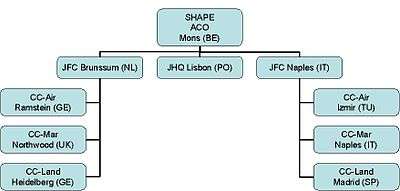
In 2003, a French flag was set up in the SHAPE headquarters in Mons following the return, after almost forty years, of French military officers to the HQ.[35] Fifteen French military officers, including General Jean-Jacques Bart, work there, of a total amount of 1,100 personnel.[35] They are however considered as "inserted," and not as "integrated," as they cannot be ordered to move without previous French approval.[35]
A new structure was developed with three main headquarters under Allied Command Operations:[36]
- Allied Joint Force Command Brunssum, Netherlands
- Component Command - Air, Ramstein
- Component Command - Maritime, Northwood
- Command Component - Land, Heidelberg
- Allied Joint Force Command Lisbon, Portugal
- Allied Joint Force Command Naples, Italy
- Component Command - Air, Izmir
- Component Command - Maritime, Naples
- Component Command - Land, Madrid
Between 2003 and 2006, a new category of forces was created, principally to improve the flexibility and reach of land forces. The structure incorporated six "NATO Rapid Deployable Corps headquarters."[37] Formed from October 2003, the NATO Rapidly Deployable Corps are designated High Readiness Forces (HRF), designed to be able to react on short notice. Although these forces cannot deploy on five days warning like the NATO Response Force (NRF), they have a longer sustainment capability in combat than the NRF, which is limited to 30 days.
- Allied Rapid Reaction Corps based at Imjin Barracks, Innsworth, Gloucester, England which is rapidly deployable within five days, but lacks sustained capability, limited to 30 days in combat. It would serve as an advance force for follow on NATO forces.
- I. German/Dutch Corps based in Münster, Germany
- NATO Rapid Deployable Italian Corps, Ugo Mara Barracks HQ in Solbiate Olona near Milan, Italy
- 3rd Corps/NATO Rapid Deployable Corps – Turkey (NRDC-T), HQ near Istanbul, Turkey [38]
- NATO Rapid Deployable Spanish Corps in Valencia, Spain [39]
- NATO Rapid Deployable Corps – Greece based on the "C" Corps HQ in Thessaloniki, Greece (now redesignated as a Force of Lower Readiness (FLR))
The Multinational Corps Northeast headquartered in Szczecin, Poland, was seen along with the downgraded Greek corps, as the third echelon deployable force in the NATO rapid deployment capability. The Eurocorps HQ, in Strasbourg, France, is an EU force with a technical agreement linking it to NATO.
As of 2017, there are nine High Readiness Force Headquarters:
- 1 German-Netherlands Corps, Münster, Germany
- Allied Rapid Reaction Corps (ARRC), Innsworth
- Multinational Corps Northeast (MNC-NE), Szczecin
- NATO Rapid Deployable Corps Italy (NRDC-IT), Solbiate Olona
- NATO Rapid Deployable Corps Spain (NRDC-Spain), Valencia
- NATO Rapid Deployable Corps Turkey (NRDC-T), Istanbul
- NATO Deployable Corps Greece (NRDC-GR) Thessaloniki
- Rapid Reaction Corps France (RRC-FR), Lille[40]
Certification of the following High Readiness Forces (Maritime) Headquarters took place in 2004:[41]
- Headquarters Commander Italian Maritime Forces on board Italy's INS Garibaldi;
- Headquarters Commander Spanish Maritime Forces (HQ COMSPMARFOR) on board SPS Castilla;
- Headquarters Commander United Kingdom Maritime Forces (HQ COMUKMARFOR)
Naval Striking and Support Forces NATO (STRIKFORNATO), homeported at Gaeta, Italy, whose lead nation is the United States, is commanded by Commander United States Sixth Fleet, and is also part of the NATO Force Structure. STRIKFORNATO is the only command capable of leading an expanded maritime task force.[42]
The final formation is Commander French Maritime Forces, initially aboard the Charles de Gaulle, but now aboard the amphibious ship Mistral. The French naval component is drawn from the Force d'Action Navale, the French Navy's surface fleet.
Island Commander, Iceland, remains in existence as a detachment of HQ ACO,[43] as does Allied Submarine Command, a NATO command based on the United States Navy's ComSubLant. A special operations coordination centre and an intelligence fusion centre have also recently been formed within SHAPE.
As more capable rapid reaction forces were established, earlier 'fire brigades', including the ACE Mobile Force (Land) ('AMF (L)'), were disbanded; AMF(L) was disbanded on 30 October 2002.[44]
In addition to this Allied Command Operations has at its disposal standing forces such as:
- NATO Airborne Early Warning Force (NAEWF)
- Standing NATO Maritime Group 1 (SNMG1)[45]
- Standing NATO Maritime Group 2 (SNMG2)
- Standing NATO Mine Countermeasures Group 1 (SNMCMG1)
- Standing NATO Mine Countermeasures Group 2 (SNMCMG2)
Airlift support for SACEUR's travels is provided by the USAF's 309th Airlift Squadron at Chièvres Air Base, Belgium.
In 2012 and 2013, NATO underwent a reorganization of the military command, and the land component commands at Heidelberg and Madrid were deactivated,[46] the maritime component command at Naples was closed[47] and the air component command at Izmir also shut down.[48]
Structure
The NATO Military Command Structure consists of two strategic commands directed by the North Atlantic Council:[49]
- Liaison: Provides advice and support to the NAC
| Political strategic level: | |||||||||||||||||||
| NATO SG (NAC) Brussels, BE | IS Brussels, BE | ||||||||||||||||||
| Military strategic level: | |||||||||||||||||||
CMC (NATO MC) | |||||||||||||||||||
 SACEUR (ACO, SHAPE) Mons, BE | 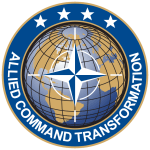 SACT (ACT, HQ SACT) Norfolk, US | ||||||||||||||||||
| Operational level: | |||||||||||||||||||
Today Allied Command Operations (ACO) is one of the two strategic commands of NATO (the other being Allied Command Transformation (ACT).
Joint force operational headquarters
There were initially two joint force operational headquarters and several single service commands [50] under Allied Command Operations:
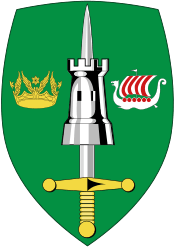

In 2018, it was agreed that a new headquarters in Norfolk would be created to conduct operations in the Atlantic. Joint Force Command Norfolk (JFCNF) was established due to the rising Russian threat, making the Atlantic sea routes a critical domain.[51] A Joint Support Enabling Command (JSEC) was also created in Ulm, Germany, to improve rear area logistical support.[52]
Single-service commands
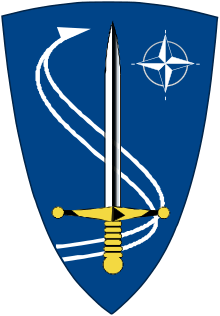
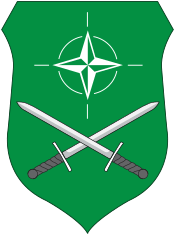
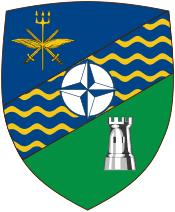
Other commands
- Naval Striking and Support Forces NATO (aka. Strike Force NATO, STRIKFORNATO) at Oeiras, Portugal
- NATO Communications and Information Systems Services Agency (NCISG) at Mons, Belgium
Supreme Allied Commander Europe

Since 2003 the Supreme Allied Commander Europe (SACEUR) has also served as the head of Allied Command Europe and the head of Allied Command Operations.
In popular culture
Ian Fleming referenced SHAPE in his short-story 'From a View to a Kill', collected as part of For Your Eyes Only.
In the film Private Benjamin, Goldie Hawn's character negotiates an assignment to SHAPE.
See also
- Western Union, SHAPE's precursor
- Operational headquarters of the European Union
- Berlin Plus agreement
References
- SHAPE, 7010 Casteau Belgium "SHAPE on NATO homepage". Retrieved 2006-03-12.
- Pedlow, Evolution of NATO's Command Structure 1951-2009.
- NATO, History of SHAPE and Allied Command Operations, updated 14 March 2007
- Brian L. Davis, NATO Forces: An Illustrated Reference to their Organization and Insignia, Blandford Press, London, 1988, p. 20.
- "Chapter 7 – The Military Structure – Allied Command Europe". NATO the first five years 1949–1954. NATO. Retrieved 17 June 2011.
- "Appendix 1 – Chronicle". NATO the first five years 1949–1954. NATO. Retrieved 3 September 2008.
- Lord Ismay, NATO: The First Five Years 1949–54, Chart 9: Allied Command Europe July 1954
- "Who is who at NATO" (PDF). NATO. Retrieved 3 October 2008.
- "The NATO Exercises, Part 1" Flight (September 26, 1952) p. 402-404.
- "The NATO Exercises, Part II", Flight, p. 489-454
- Time, September 29, 1952
- "NATO Ships Enter Baltic Sea" - Sydney Morning Herald, p. 2.
- David C. Isby & Charles Kamps Jr, Armies of NATO's Central Front, Jane's Publishing Company Ltd 1985, p.15, ISBN 0-7106-0341-X
- For the original document see NATO, Military Committee 14/1. Retrieved June 2008.
- "Chapter 9". NATO the first five years 1949–1954. NATO. Retrieved 3 November 2008."Chapter IX-B". NATO the first five years 1949–1954. NATO. Retrieved 3 November 2008.
- "Emergency Call". TIME. September 30, 1957. Retrieved 2008-11-03.
- "Emergency Call". Time. 30 September 1957. Retrieved 3 October 2008.
- "All Ashore". Time. 7 October 1957. Retrieved 7 November 2008.
- John Clearwater. Canadian Nuclear Weapons: The Untold Story of Canada's Cold War Arsenal, p. 121
- IISS Military Balance 1982, p. 24.
- 'US Security Issues in Europe,' 93rd Congress, 1973, p.13, cited in William Park 'Defending the West,' Wheatsheaf Books, 1986, p.30
- NATO, Original SHAPE relocation article, verified August 2008
- Sean Maloney, To Secure Command of the Sea, University of New Brunswick thesis, 1991, clearly depicts the predominance of US and UK officers in senior command positions
- See also L. James Binder, Lemnitzer: A Soldier For His Time
- Franco Veltri, AFSOUTH 1951–2004: Over Fifty Years Working for Peace and Stability Archived 2007-10-13 at the Wayback Machine, AFSOUTH, April 2004
- Len Colodny and Tom Shachtman, The Forty Years War: The Rise and Fall of the Neocons, From Nixon to Obama (Harper, 2009), 274, 280–81, 282–83.
- Galvin, Fighting the Cold War, University Press of Kentucky, 2015, 237-8.
- "German Guilty in '79 Attack At NATO on Alexander Haig". The New York Times. November 25, 1993.
- Source: IISS Military Balance 1981–82, p. 25
- Allied command structures in the New NATO, DIANE Publishing edition, 13.
- Barbara Starr, 'Allies want a simplified command for Europe,' Jane's Defence Weekly, 16 October 1996, p. 6.
- Cevik, Ilnur (1996-12-13). "Turkey eyes French-US NATO command debate with concern". Turkish Daily News. Alt URL
- For an American view of this dispute, see Ronald Tiersky, French Gamesmanship and the Future of the Alliance: The Case of Allied Forces Southern Europe Archived 2009-05-21 at the Wayback Machine, NDU/INSS, 1997
- Sydney Blumenthal, The Clinton Wars, New York, Plume, 2003, p.650-1, cited in Dale R. Herspring, The Pentagon and the Presidency, University Press of Kansas, 2005, p.372-3. See also General's Early Exit Upsets NATO by Joseph Fitchett for the International Herald Tribune on July 29, 1999. Retrieved February 3, 2007.
- Arnaud De La Grange, La France amorce un "mouvement" vers l’Otan, Le Figaro, 26 September 2007 (in French)
- "The Evolution of NATO's Command Structure, 1951-2009" (PDF). NATO. Retrieved 16 April 2013.
- NATO, NATO's New Command Structure, verified September 2008
- UÇAR, Barış. "NATO Rapid Deployable Corps - Turkey". www.hrf.tu.nato.int.
- Ejercito.mde.es Archived 2010-09-23 at the Wayback Machine
- "Rapid Deployable Corps". NATO. 9 November 2015. Retrieved 20 June 2017.
- International Military Staff, The New NATO Force Structure, updated 2006, verified September 2008
- Naval Striking and Support Forces NATO, Factsheet: High Readiness Force Archived 2009-04-17 at the Wayback Machine. Retrieved September 2008.
- MC 324/1 "NATO Military Command Structure", 2003
- NATO, NATO Press Release (2002)098 – 12 August 2002
- AMCC-Northwood, History of Standing NATO Maritime Group 1 Archived 2008-09-24 at the Wayback Machine, verified September 2008
- Vandiver, John (30 November 2012). "NATO Activates Allied Land Command". Stars and Stripes. Retrieved 2 February 2013.
- "Deactivation ceremony of Allied Maritime Command Naples". Headquarters Allied Joint Force Command Naples. Retrieved 16 April 2013.
- "NATO deactivates allied air command Izmir headquarters Turkey". NATO. Retrieved 16 April 2013.
- "Command Structure" (PDF). NATO. Retrieved 19 October 2019. and "Military Command Structure". shape.nato.int. Supreme Head Allied Powers Europe. 12 February 2020. Retrieved 12 February 2020.
- "Structure". NATO. Retrieved 14 June 2014.
- "Military Command Structure". hape.nato.int. Supreme Headquarters Allied Powers Europe. 12 February 2020. Retrieved 12 February 2020.
The operational level consists of three standing Joint Force Commands (JFCs): one in Brunssum, The Netherlands, one in Naples, Italy and one in Norfolk, Virginia
- "Joint Support and Enabling Command". jsec.nato.int/. JSEC. 4 April 2020. Retrieved 4 April 2020.
As an operational-level international headquarters, the Joint Support and Enabling Command (JSEC) is part of the new NATO Force Structure. Its overall mission is to provide SACEUR with a secure Rear Area in crises up to maximum level of effort by supporting Nations in their planning, execution and coordination of Security, Force Protection and Area Damage Control.
Further reading
- Hackett, John. "NATO's Supreme Allied Commanders on Parade." Parameters 18, no. 2 (1988): 2.
- Jordan, Robert S. Norstad: Cold War NATO Supreme Commander – Airman, Strategist, Diplomat St. Martin's Press, 2000. 350 pp.
- Jordan, Robert S., ed. Generals in International Politics: NATO's Supreme Allied Commander, Europe. University Press of Kentucky, 1987.
- Lt. Col. William A. Knowlton, Early Stages in the Organization of SHAPE, International Organization, Volume 13, No.1, Winter 1959
- Jane's NATO Handbook Edited by Bruce George, 1990, Jane's Information Group ISBN 978-0-7106-0598-6
- Jane's NATO Handbook Edited by Bruce George, 1991, Jane's Information Group ISBN 978-0-7106-0976-2
- Vojtech Mastny, Sven S. Holtsmark, Andreas Wenger (ed.), War Plans and Alliances in the Cold War: Threat Perceptions in the East and West
External links
| Wikimedia Commons has media related to Supreme Headquarters Allied Powers Europe. |
- Official website

- How SHAPE took SHAPE (from NATO's website)
- Allied Command Operation SitRep
- The New NATO Force Structure
- EUobserver – Nato's new headquarters to cost €1 billion
- History of SHAPE
- "Senior officials in the NATO military structure, from 1949 to 2001" (PDF). (32 KB)
- NATO Flickr photostream
